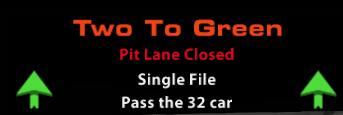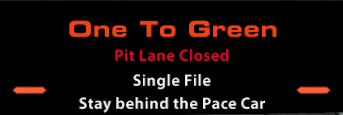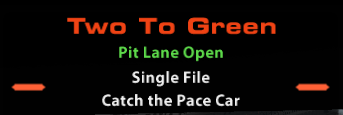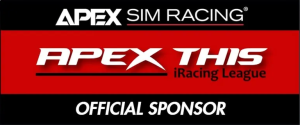Full Course Yellow Procedures




You MUST have the Pacing Black Box in a prominent position on your screen. When that box pops up, you’ll know instantly there is a Full Course Yellow. Follow the instructions given.
- There are three yellow flag laps, at the end of the third lap it goes green.
- Pit road is typically only open for one lap.
- Single file restart.
- Hustle to catch up to the pace car. If a wreck is in T1, the pace car will come out behind the field. You’ll have to make your way around the track at a good rate to catch up to it.
- Follow the instructions in the Pacing box. It tells you everything you need to know! It’s the same box that should be front & center during the race start pace lap.
- Communicate using voice chat. Another reason we want EVERY racer to have and use voice chat. If you need to get by someone, tell them you’re coming.
- Don’t STOP to let cars by, just slow a bit. If you stop, ANY car that goes by you will have gained that position. If you keep moving, they’ll be directed to let you back by.
- One To Green signifies that at the end of this lap, the green flag flies.
- If you get a black flag because someone didn’t hustle to get around you, let us know via voice chat. We’ll do our best to clear it.
How does a Full Course Yellow work in Road Races?
A FCY caution is signaled via a message box visible to the driver, a message from your spotter, and a yellow flag appears on the screen.
The order will be frozen the moment the full-course caution begins. Cars causing the caution or otherwise seen as out of control may not be awarded a place in the pacing order until they are detected as on course and under control.
iRacing Race Control will instruct the leader to follow the pace car. Don’t allow yourself to relax, you must catch up to the pace car at a good pace. All other drivers must fall in line using the instructions from Race Control that appear on the screen. To assist drivers in preparation for a restart, instructions will be shown to help with positioning. Restarts will be single-file. Follow the Race Control instructions to position yourself correctly.
Failure to line up correctly by the time you attempt a pit entry or the green flag, will result in a black flag penalty. Avoid this by hustling your car to the correct place while under yellow. Don’t be slow to get your car into position!
In the event your car is damaged or out of fuel during a FCY such that you cannot keep pace – BUT iRacing race control is giving you commands to “catch the X car” – you need to strongly consider towing. There is a good chance you’re going to cause a penalty to someone else and/or yourself. Ultimately, it might be faster to tow.
While pacing during a FCY, Race Control will signal two laps to go, then one lap to go until the green flag restart. At one lap to go, the Pace car’s overhead warning lights will go out.
FCY Restarts
During the restart, do not pass the pace car before it enters the pit lane. Your spotter will normally give an audible message letting you know when “the pace car is in.” The restart is decided by the leader, unless otherwise directed during the pre-race drivers’ meeting.
Local Yellow Flags
Local yellow Flags are common during races. iRacing race control currently does not enforce no passing under a local yellow, however, the stewards have issued penalties for secondary incidents resulting from local yellow conditions. Use caution when a local yellow is displayed. Incidents under a Local Yellow may receive a higher level of scrutiny from the stewards.
